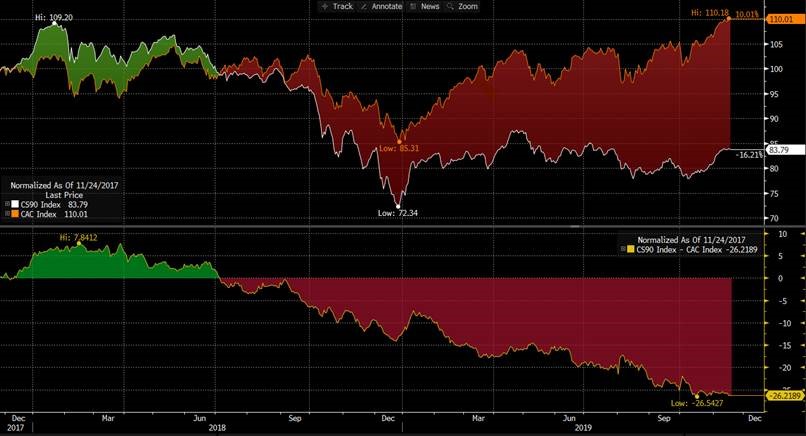 Outperformance of small cap versus large cap stocks is a well-known and studied phenomenon in the investment community. First, let s define small cap and large cap. We define as small cap companies with a public market capitalization below 1 billion euro while large cap are companies with public market capitalization above 5 billion euro. The market cap of a listed company is part of the famous 3 factors model of Fama & French in 1992 described as the size factor. The others 2 factors being the original Capital Asset Pricing Model and the value factor. There is plenty of financial literature that prove that smaller size companies tend to deliver better returns and outperforms their bigger peers. The outperformance is explained by various reasons but mainly they carry a higher risk premium, so they necessarily deliver higher returns. One explanation of this higher risk premium is their poor liquidity with smaller trading volume.
Outperformance of small cap versus large cap stocks is a well-known and studied phenomenon in the investment community. First, let s define small cap and large cap. We define as small cap companies with a public market capitalization below 1 billion euro while large cap are companies with public market capitalization above 5 billion euro. The market cap of a listed company is part of the famous 3 factors model of Fama & French in 1992 described as the size factor. The others 2 factors being the original Capital Asset Pricing Model and the value factor. There is plenty of financial literature that prove that smaller size companies tend to deliver better returns and outperforms their bigger peers. The outperformance is explained by various reasons but mainly they carry a higher risk premium, so they necessarily deliver higher returns. One explanation of this higher risk premium is their poor liquidity with smaller trading volume.
Analyst coverage is also lower compared to larger stocks. The number of analysts following small cap stories is on average 5 times smaller than blue chip companies. Small cap have a higher asymmetric risk due to their lower liquidity and tend to suffer extreme price correction during economic downturn. Empirical and behavioural finance studies have demonstrated that small cap exhibit a systematic valuation anomaly as many institutions ignore stocks below a certain size and liquidity threshold. This lack of coverage and ownership drives inefficiency as the small cap universe is much larger and diverse than large cap one.
We estimate there are nearly 1300 constituents in the European mid and small cap space. This creates an opportunity for patient manager willing to invest the time and energy required to invest in smaller companies. This valuation anomaly disappears as companies grow and become more widely followed. On top of this market participant bias, there is a structural reason, for -successful- smaller companies to deliver higher returns, their small size gives them a higher agility to be more innovative and experience higher growth rate in revenues and profits than stable and mature companies. Additionally, they can represent good acquisition candidates by larger companies that would like to develop and adapt their services/products on a bigger scale.
Another reason of good performance of small cap stock, and often overlooked, is their management. Small cap stocks are often controlled and run by their original founder that still hold significant stake in their companies despite being listed. This “skin in the game” effect often produces optimal operational execution and sensible capital allocation decisions with a focus on long term benefits. Actually, talking to and evaluating management is a crucial point in small cap investing.
A final element to take into consideration when investing in European small cap is to understand that this universe is a derivative component of three other markets/asset class. The equity market is a derivative of the bond market, the European equity market is a derivative of the US equity market and finally small cap are a derivative of large cap. This inter connection and dependency implies that despite a thorough and meticulous analysis, investors can still suffer losses from exogeneous factors.
In a more pragmatic approach, I would like to point out that we currently find ourselves in the middle of this valuation anomaly described previously in this paper. The deterioration of the perception of the economic environment has left the European equity market with plenty of small cap companies trading a multi years or historical low valuations with sound and improving fundamentals, viable business models and extremely well managed by their founding management.

CAC 40 index vs CS90 index
It is particularly true in countries like France, Italy and the UK. For example, the French Small Cap Index is underperforming the blue-chip CAC 40 Index by 30 % over the last 2 years. These reasons behind this situation are various. The change in regulation with the new MIFID 2 rules has highly disrupted the brokerage research industry with research budgets being slashed at big investments banks and brokers. Therefore, small cap companies are getting less coverage and fewer research reports are now available for investors to discover and study those companies.
Actively managed funds have suffered constant outflows for many months in a row since the debacle of 2018. On the contrary, the exponential growth of passive flows and ETF investing is creating a snowball effect where new investments go principally into ETF/Index members stocks while smaller companies are being overlooked.
As a fund manager, being successful in small cap investing requires above average stock selection ability and a higher risk tolerance. The active management world being more and more under pressure there is less people to follow and invest in those names. While passive index investing has become the norm, we believe this behaviour does not create long term value for shareholders and the economy globally. There is no doubt this gap will resolve in the future, but the timing of this recovery could prove to take longer than anticipated.
Contributo a cura di
Omar Aouane – Gestore Zest